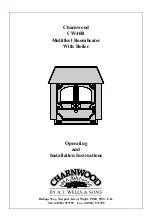
position as required (the tool should
be horizontal for solid fuel or vertical
for wood or peat).
REFUELLING
Keep the firebox well filled (the fuel
may be sloped up from the front
firebars), but do not allow fuel to
spill over the top of the front fire
bars. Take care, especially when
burning wood, that fuel does not
project over the front fire bars or
damage to the glass may be caused
when the doors are closed.
OVERNIGHT
BURNING
Empty the ashpan, if necessary, and
then riddle the fire if you are burning
solid fuel. If the fire is very low then
it may be necessary to add a little fuel
and turn the thermostat control up to
maximum for a brief period until the
fire is burning brightly before filling
with fuel. When burning wood use
large logs overnight as they will burn
more slowly than small ones.
If the central heating pump is off
overnight then the thermostat may be
left at the same setting for both day
and night operation. If the central
heating pump is on overnight then
set the thermostat control to give the
required level of heating.
Some experimentation may be
necessary to find the setting most
suitable for the particular fuel used
and the draw on the chimney.
For overnight burning the fire doors
must be closed.
To revive the fire, empty the ashpan
if necessary, riddle, (when burning
solid fuel), and turn the thermostat
control knob to maximum. When the
fire is burning well load on more fuel
as necessary and turn the control
knob to the desired setting.
When burning wood do not riddle but
simply turn the air control to
maximum until the fire picks up and
then set the air control at the desired
setting and refuel as necessary.
THROAT PLATE AND
FLUEWAY CLEANING
It is important that every month the
throat plate and all the appliance
flueways are thoroughly cleaned. It is
not necessary to let the fire out
completely to do this.
The throat plate should be lowered
using the tool. The method of doing
this is shown in Fig. 1. Any sooty
deposits should then be swept from
the plate and into the fire. Using the
tool provided the two boiler tubes
should be cleaned as shown in Fig. 2.
More soot will be deposited on the
throat plate and in the flueways if the
appliance is run at low levels for long
periods. If this is the case then more
frequent cleaning will be necessary.
SPECIAL POINTS
WHEN BURNING
COAL
When burning housecoal keep the
secondary air control open all the
time.
When loading the fire take care not
to smother the fire, instead fill the
firebox in two stages waiting between
each stage for the flames to appear
above the fire.
After a period of slumbering always
turn the air control up to maximum
and wait until flames appear above
the fuel bed before opening the doors.
Burning coal will produce more soot
deposits than other fuels, especially if
the fire is run at low levels for long
periods. It is therefore vital to clean
the throat plate regularly.
CLEANING AND
MAINTENANCE
The appliance is finished in vitreous
enamel. To clean the surfaces simply
wipe over with a dry cloth. Abrasive
pads and scouring cleaners must not
be used as these will damage the
finish. Care should be taken not to
knock the enamel with hard objects
as it will chip.
The glass in the doors is a zero
expansion ceramic glass which will
not crack due to the heat of the fire.
Before cleaning the glass open the
doors and allow them to cool. Clean
the glass using a damp cloth and then
wiping over with a dry cloth. Any
stubborn deposits on the glass may be
removed with a proprietary stove
glass cleaner or ceramic hob cleaner.
Some deposits on the glass may be
burnt off simply by running the fire
at a fast rate for a few minutes. Do
not use abrasive cleaners or pads as
these can scratch the surface which
will weaken the glass and cause
Page 5
CW40B 3/95




























